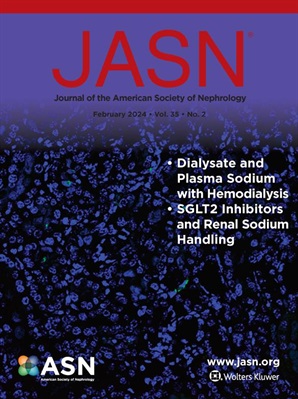Validation of the Klinrisk Machine Learning Model for CKD Progression in a Large Representative US Population.
IF 9.4
1区 医学
Q1 UROLOGY & NEPHROLOGY
引用次数: 0
Abstract
BACKGROUND Early identification of high-risk chronic kidney disease (CKD) can facilitate optimal medical management and improve outcomes. We aimed to validate the Klinrisk machine learning model for prediction of CKD progression in large US commercial, Medicare, and Medicaid populations. METHODS We developed three cohorts, consisting of insured adults enrolled in a) commercial, b) Medicare, and c) Medicaid plans between 01/01/2007 and 12/31/2020 with ≥1 serum creatinine test, an eGFR between 15ml/min/1.73m 2 and 180ml/min/1.73m 2 , and ≥7 of the 19 other laboratory analytes available. Two primary sub-cohorts were evaluated within each insurer: (1) all patients with ≥7 laboratory analytes; and (2) patients in (1) with available urinalysis results. Disease progression was defined as the composite outcome of a sustained 40% decline in eGFR or kidney failure. Discrimination, accuracy, and calibration were assessed using the area under the receiver operator characteristic curve (AUC), Brier scores, and calibration plots. RESULTS In the commercial cohort, the Klinrisk model achieved AUCs ranging from 0.83 (95% confidence interval: 0.82 - 0.83) to 0.87 (0.86 - 0.87) and a maximum Brier score of 0.005 (0.0005 - 0.005) at 2 years. In Medicare patients, AUCs ranged from 0.80 (0.79 - 0.80) to 0.81 (0.80 - 0.82), with a maximum Brier score of 0.026 (0.025 - 0.027). In Medicaid patients, we found AUCs ranging from 0.82 (0.82 - 0.82) to 0.84 (0.82 - 0.86) and a maximum Brier score of 0.014 (0.012 - 0.015). CONCLUSIONS The Klinrisk machine learning model was accurate in predicting CKD progression in 4.8 million US adults across commercial, Medicare, and Medicaid populations.Klinrisk机器学习模型在美国大量代表性人群中CKD进展的验证
背景:准确识别高危慢性肾脏疾病(CKD)有助于优化医疗管理和改善预后。我们的目的是验证Klinrisk机器学习模型在美国大型商业、医疗保险和医疗补助人群中对CKD进展的预测。方法:我们开发了三个队列,包括在2007年1月1日至2020年12月31日期间参加a)商业,b)医疗保险和c)医疗补助计划的参保成年人,血清肌酐试验≥1,eGFR在15ml/min/1.73m 2至180ml/min/1.73m 2之间,以及19种其他实验室分析中≥7种。在每个保险公司中评估两个主要亚队列:(1)所有具有≥7项实验室分析的患者;(2)(1)有尿检结果的患者。疾病进展被定义为eGFR持续下降40%或肾衰竭的复合结果。采用接收操作者特征曲线(AUC)下面积、Brier评分和校准图评估识别、准确性和校准。结果在商业队列中,Klinrisk模型在2年时的auc范围为0.83(95%置信区间:0.82 - 0.83)至0.87(0.86 - 0.87),最大Brier评分为0.005(0.0005 - 0.005)。在医保患者中,auc范围为0.80(0.79 - 0.80)至0.81(0.80 - 0.82),最大Brier评分为0.026(0.025 - 0.027)。在医疗补助患者中,我们发现auc范围为0.82(0.82 - 0.82)至0.84(0.82 - 0.86),最大Brier评分为0.014(0.012 - 0.015)。结论:Klinrisk机器学习模型在预测480万美国成年人(包括商业、医疗保险和医疗补助人群)的CKD进展方面是准确的。
本文章由计算机程序翻译,如有差异,请以英文原文为准。
求助全文
约1分钟内获得全文
求助全文
来源期刊
CiteScore
22.40
自引率
2.90%
发文量
492
审稿时长
3-8 weeks
期刊介绍:
The Journal of the American Society of Nephrology (JASN) stands as the preeminent kidney journal globally, offering an exceptional synthesis of cutting-edge basic research, clinical epidemiology, meta-analysis, and relevant editorial content. Representing a comprehensive resource, JASN encompasses clinical research, editorials distilling key findings, perspectives, and timely reviews.
Editorials are skillfully crafted to elucidate the essential insights of the parent article, while JASN actively encourages the submission of Letters to the Editor discussing recently published articles. The reviews featured in JASN are consistently erudite and comprehensive, providing thorough coverage of respective fields. Since its inception in July 1990, JASN has been a monthly publication.
JASN publishes original research reports and editorial content across a spectrum of basic and clinical science relevant to the broad discipline of nephrology. Topics covered include renal cell biology, developmental biology of the kidney, genetics of kidney disease, cell and transport physiology, hemodynamics and vascular regulation, mechanisms of blood pressure regulation, renal immunology, kidney pathology, pathophysiology of kidney diseases, nephrolithiasis, clinical nephrology (including dialysis and transplantation), and hypertension. Furthermore, articles addressing healthcare policy and care delivery issues relevant to nephrology are warmly welcomed.

 求助内容:
求助内容: 应助结果提醒方式:
应助结果提醒方式:


